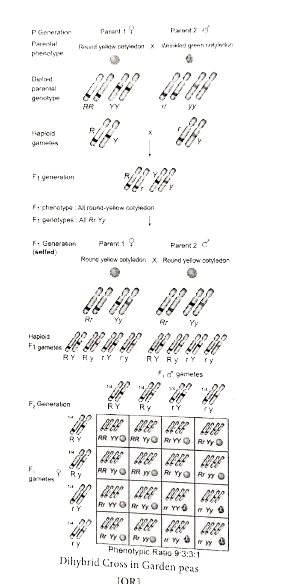Saved Bookmarks
| 1. |
Question : What are the objectives of Afforestation programme? |
|
Answer» Solution :(a) The crossing of two plants differing in two pairs of contrasting traits is called dihybrid cross. In dihybrid cross, two characters (colour and shape) are considered at a time. Mendel considered the seed shape (round and wrinkled) and cotyledon colour (yellow & green) as the two characters. In seed shape round (R ) is dominant over wrinkled (r ), in cotyledon colour yellow (Y) is dominant over green (y). Hence the pure breeding round yellow parent is represented by the genotype RRYY and the pure breeding green wrinkled parent is represented by the genotype rryy. During gamete formation the genes of a character assort out independetly of the other pair. During the `F_(1)XX F_(1)` fertillization each zygote with an equal probability receives one of the four combinations from each parent. The resultant gametes thus will be genetically different and they are of the following four types : (1) Yellow round (YR) - 9/16 (2) Yellow wrinkled (Yr) - 3/16 (3) Green round (yR) - 3/16 (4) Green wrinkled (yr) - 1/16 These four types of gametes of `F_(1)` dihybrids unite randomly in the process of fertillization and produce sixteen types of individuals in `F_(2)` in the ratio of 9:3:3:1 as shown in the figure. Mendel.s 9:3:3:1 dihybrid ratio is an ideal ratio based on the probability including segregation, independent assortment and random fertillization. In sexually reproducing organism / plants from the garden peas to human beings, Mendel.s findings laid the foundation for understanding inheritance and revolutionized the field of biology. The dihybrid cross and its result led Mendel to propose a second set of generalisations that we called Mendel.s Law of independent assortment.  Afforestation Objectives : • To increase forest cover, PLANTING more tress, increases `CO_(2)` production and air quality. • Rehabilitation of degraded forest to increase carbon flaxation and reducing `CO_(2)` from atmosphere. • RAISING bamboo planatations. •Mixed plantations of minor forest produce and medicinal plants. •REGENERATION of indigenous herbs / shrubs. •Awareness creation, monitoring and evalution. •To increase the level and availability of water table or ground water and also to reduce nitrogen leaching in soil and nitrogen contamination of drinking water, thus making it pure not polluted with nitrogen. •Nature aided artificial regeneration. |
|
Discussion
No Comment Found
Related InterviewSolutions
- Question : Which is the most common mechanism of genetic variation in the population of a sexually reproducing organism?
- Question : Which is the most common methods of fossilization? Explain how it occurs.
- Question : Which is the most common mechanism of genetic variation in the population of a sexually reproducing organism ?
- Question : Which is the microscopic parasitic animal ?
- Question : Which is the method of temporary birth control that reduces the chances of pregnancy by 80%? Write the fact on which this method is based.
- Question : Which is the main cause to convert water bodies into land ?
- Question : Which is the lowest level of ecological organisation ?
- Question : Which is the longest cell of the human body ?
- Question : Which is the longest bone of the body ?
- Question : Which is the link between glycolysis and Krebs cycle·?